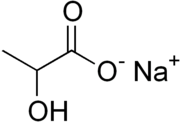This is an old revision of this page, as edited by CheMoBot (talk | contribs) at 15:40, 15 February 2012 (Updating {{chembox}} (no changed fields - added verified revid - updated 'DrugBank_Ref', 'UNII_Ref', 'ChEBI_Ref', 'KEGG_Ref') per Chem/Drugbox validation (report errors or [[user talk:CheMo...). The present address (URL) is a permanent link to this revision, which may differ significantly from the current revision.
Revision as of 15:40, 15 February 2012 by CheMoBot (talk | contribs) (Updating {{chembox}} (no changed fields - added verified revid - updated 'DrugBank_Ref', 'UNII_Ref', 'ChEBI_Ref', 'KEGG_Ref') per Chem/Drugbox validation (report errors or [[user talk:CheMo...)(diff) ← Previous revision | Latest revision (diff) | Newer revision → (diff) | |||
| |||
| Names | |||
|---|---|---|---|
| IUPAC name Sodium 2-hydroxypropanoate | |||
| Other names Sodium DL-lactate; Lactic acid sodium salt; E325 | |||
| Identifiers | |||
| CAS Number | |||
| 3D model (JSmol) | |||
| ChEMBL | |||
| ChemSpider | |||
| ECHA InfoCard | 100.000.702 | ||
| E number | E325 (antioxidants, ...) | ||
| PubChem CID | |||
| CompTox Dashboard (EPA) | |||
InChI
| |||
SMILES
| |||
| Properties | |||
| Chemical formula | C3H5NaO3 | ||
| Molar mass | 112.06 g/mol | ||
| Appearance | White powder | ||
| Density | 1.33 g/mL, 1.31 g/ml (60 % syrup) | ||
| Melting point | 161–162 °C 17 °C (60 % syrup) | ||
| Boiling point | 113 °C (60 % syrup) | ||
| Solubility in water | Miscible | ||
| Except where otherwise noted, data are given for materials in their standard state (at 25 °C , 100 kPa).
| |||
Sodium lactate is the sodium salt of lactic acid produced by fermentation of a sugar source, such as corn or beets, and then neutralizing the resulting lactic acid to create a compound having the formula NaC3H5O3. As a food additive, sodium lactate has the E number E325 and naturally is a liquid product, but also is available in powder form. As early as 1836, sodium lactate was recognized as a salt of a weak acid rather than being a base, and it was then known that the lactate had to be metabolized in the liver before the sodium could have any titrating activity.
Usage
Sodium lactate has a mild saline taste. It may be used in shampoo products and other similar items such as liquid soaps as it is an effective moisturiser.
Sodium lactate commonly is used to treat arrhythmias caused by overdosing of class I antiarrythmics, as well as pressor sympathomimetics which can cause hypotension.
Regarding milk
Sodium lactate need not be restricted by someone avoiding milk or those with a milk allergy. In general, lactates such as sodium, calcium, and potassium lactate are salts derived from the neutralization of lactic acid and most commercially used lactic acids are fermented from dairy-free products such as cornstarch, potatoes, or molasses. Sugar or tapioca additionally may be used. However some lactic acid is fermented from dairy products such as whey and lactose. Whey is made of up 6.5 % solids of which 4.8 % is solid lactose. Waste whey typically is used to produce lactic acid when the whey itself is produced as waste during the manufacture of certain dairy products. As a result, such dairy-type lactic acid generally goes back into dairy products, such as ice cream and cream cheese, rather than into non-dairy products. Moreover, although the lactic-acid starter culture to ferment corn or beets may contain milk, sodium lactate does not contain milk protein and need not be restricted by someone avoiding milk or those with a milk allergy.
Pharmacy
For pharmacy purpose, 60 % solution is used according to US Pharmacopoeia, which has pH 7 ±0.5, specific gravity 1.31–1.34 g/ml, and is colourless, odourless, slightly viscous and slightly salty tasting and is stable with indefinite shelf life.
References
- ^ Sodium lactate, chemblink.com
- ^ Sodium Lactate, Powder, lotioncrafter.com
- ^ Safety data for sodium lactate syrup
- ^ Silberberg, Barrie (2009). The Autism and ADHD Diet: A Step-by-Step Guide to Hope and Healing by Living Gluten Free and Casein Free (GFCF) and Other Interventions. Sourcebooks, Inc. p. 119. ISBN 1402218451.
- Mills, Lewis C. (1836). Shock and hypotension: pathogenesis and treatment: the twelfth Hahnemann symposium. Grune & Stratton. p. 369.
{{cite book}}: Unknown parameter|coauthors=ignored (|author=suggested) (help) - Trevor, Anthony (2008). Katzung & Trevor's Pharmacology Examination and Board Review (8e ed.). Go Dairy Free. p. 126. ISBN 0071488693.
{{cite book}}: Unknown parameter|coauthors=ignored (|author=suggested) (help) - ^ Willitts, Alice (2007). Food allergy & your child. Class Publishing Ltd. p. 85. ISBN 1859591868.
The following ingredients do not contain milk protein and need not be avoided by people allergic to milk: … Sodium lactate
{{cite book}}: Unknown parameter|coauthors=ignored (|author=suggested) (help) - ^ Fleming, Alisa Marie (2008). Go Dairy Free: The Guide and Cookbook for Milk Allergies, Lactose Intolerance, and Casein-free Living. Go Dairy Free. p. 90. ISBN 0979128625.
- Ranken, M. D. (1997). Food industries manual. Springer. p. 125. ISBN 0751404047.
{{cite book}}: Unknown parameter|coauthors=ignored (|author=suggested) (help) - Inamdar (2009). Biochemical Engineering: Principles And Concepts. PHI Learning Pvt. Ltd. p. 254. ISBN 8120336771.
- http://www.wilkeinternational.com/WILKEinternational/SodiumLactate.html

